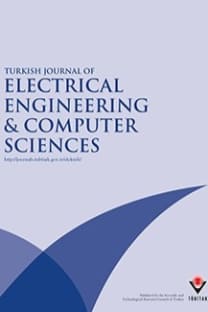A new cascaded multilevel inverter with series and parallel connection ability of DC voltage sources
Multilevel inverter, series-parallel connection, basic unit
A new cascaded multilevel inverter with series and parallel connection ability of DC voltage sources
Multilevel inverter, series-parallel connection, basic unit,
___
- using 19 IGBTs and the structures given in [15], [16], and [20] produce 53, 49, and 51 voltage levels using 22, 24, and 29 IGBTs, respectively.
- A. Nabae, I. Takahashi, H. Akagi, “A new neutral-point clamped PWM inverter”, IEEE Transactions on Industry Applications, Vol. IA-17, pp. 518–523, 1981.
- T.A. Meynard, H. Foch, P. Thomas, J. Courault, R. Jakob, M. Nahrstaedt, “Multicell converters: basic concepts and industry applications”, IEEE Transactions on Industrial Electronics, Vol. 49, pp. 955–964, 2002.
- P.W. Hammond, “A new approach to enhance power quality for medium voltage AC drives”, IEEE Transactions on Industry Applications, Vol. 33, pp. 202–208, 1997.
- M. Malinowski, K. Gopakumar, J. Rodriguez, M.A. Perez, “A survey on cascaded multilevel inverters”, IEEE Transactions on Industrial Electronics, Vol. 57, pp. 2197–2206, 2010.
- P.W. Hammond, “Medium voltage PWM drive and method”, U.S. Pat. 05625545, 1997.
- G.A. Duba, E.S. Thaxton, J. Walter, “Modular static power converter connected in a multi-level, multi-phase, multi-circuit configuration”, U.S. Pat. 05933339, 1999.
- K.A. Corzine, Y.L. Familiant, “A new cascaded multi-level H-bridge drive”, IEEE Transactions on Power Electron- ics, Vol. 17, pp. 125–131, 2002.
- K.A. Corzine, F.A. Hardrick, Y.L. Familiant, “A cascaded multi-level H-bridge inverter utilizing capacitor voltages sources”, Proceedings of the IASTAD Power Electronics Technology and Applications Conference, 2003.
- K.A. Corzine, M.W. Wielebski, F.Z. Peng, J Wang, “Control of cascaded multi-level inverters”, IEEE Transactions on Power Electronics, Vol. 19, pp. 732–738, 2004.
- J. Wen, K.M. Smedley, “Synthesis of multilevel converters based on single- and/or three-phase converter building blocks”, IEEE Transactions on Power Electronics, Vol. 23, pp. 1247–1256, 2008.
- P. Lezana, G. Ortiz, “Extended operation of cascade multicell converters under fault condition”, IEEE Transactions on Industrial Electronics, Vol. 56, pp. 2697–2703, 2009.
- W. Song, A.Q. Huang, “Control strategy for fault-tolerant cascaded multilevel converter based STATCOM”, Proceedings of the 22nd IEEE Applied Power Electronics Conference, pp. 1073–1076, 2007.
- J.I. Rodriguez, S.B. Leeb, “A multilevel inverter topology for inductively coupled power transfer”, IEEE Transac- tions on Power Electronics, Vol. 21, pp. 1607–1617, 2006.
- F. Zhang, S. Yang, F.Z. Peng, Z. Qian, “A zigzag cascaded multilevel inverter topology with self-voltage balancing”, Proceedings of the Applied Power Electronics Conference, pp. 1632–1635, 2008.
- E. Babaei, “A cascade multilevel converter topology with reduced number of switches”, IEEE Transactions on Power Electronics, Vol. 23, pp. 2657–2664, 2008.
- E. Babaei, “Optimal topologies for cascaded sub-multilevel converters”, Journal of Power Electronics, Vol. 10, pp. 251–261, 2010.
- E. Babaei, S.H. Hosseini, “New cascaded multilevel inverter topology with minimum number of switches”, Journal Energy Conversion and Management, Vol. 50, pp. 2761–2767, 2009.
- J. Ebrahimi, E. Babaei, G.B. Gharehpetian, “A new topology of cascaded multilevel converters with reduced number of components for high-voltage applications”, IEEE Transactions on Power Electronics, Vol. 26, pp. 3109–3118, 2011.
- J. Ebrahimi, E. Babaei, G.B. Gharehpetian, “A new multilevel converter topology with reduced number of power electronic components”, IEEE Transactions on Power Electronics, Vol. 59, pp. 655–667, 2012.
- Y. Hinago, H. Koizumi, “A single-phase multilevel inverter using switched series/parallel DC voltage sources”, IEEE Transactions on Industrial Electronics, Vol. 57, pp. 2643–2650, 2010.
- ISSN: 1300-0632
- Yayın Aralığı: Yılda 6 Sayı
- Yayıncı: TÜBİTAK
Optimization of grid connected micro-grid consisting of PV/FC/UC with considered frequency control
Hamid HASSANZADEHFARD, Seyed Masoud MOGHADDAS-TAFRESHI, Seyed Mehdi HAKIMI
Seyed Mehdi RAKHTALA, Abolfazl Ranjbar NOEI, Reza GHADERI, Elio USAI
Short-term load forecasting using mixed lazy learning method
Seyed-Masoud BARAKATI, Ali Akbar GHARAVEISI, Seyed Mohammad Reza RAFIEI
Adaptive network-based inference system models on multiband patch antenna design
Erdem DEMİRCİOĞLU, Murat Hüsnü SAZLI, Orhan ŞENGÜL, Şehabeddin Taha ˙IMECİ, Hakkı Alparslan ILGIN
Asaf Behzat ŞAHİN, Hatice Gonca BULUR
A novel efficient model for the power flow analysis of power systems
Amir SAFDARIAN, Mahmud FOTUHI-FIRUZABAD, Farrokh AMINIFAR
Reza Omidi GOSHEBLAGH, Karim MOHAMMADI
A hierarchic approach based on swarm intelligence to solve the traveling salesman problem
Mesut GÜNDÜZ, Mustafa Servet KIRAN, Eren ÖZCEYLAN
